NISSAN ROGUE SPORT 2021 Repair Manual
Manufacturer: NISSAN, Model Year: 2021, Model line: ROGUE SPORT, Model: NISSAN ROGUE SPORT 2021Pages: 516, PDF Size: 2.43 MB
Page 61 of 516
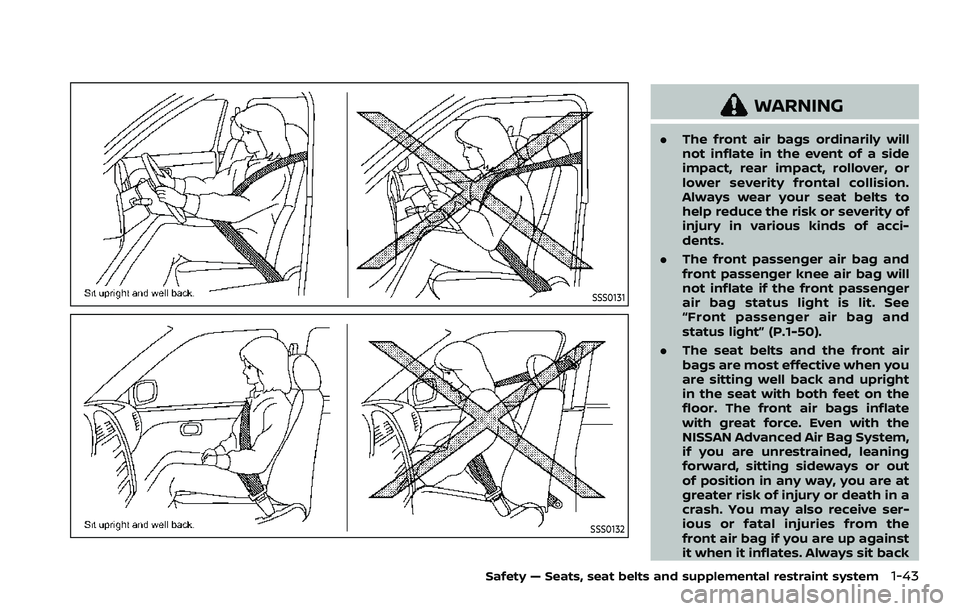
SSS0131
SSS0132
WARNING
.The front air bags ordinarily will
not inflate in the event of a side
impact, rear impact, rollover, or
lower severity frontal collision.
Always wear your seat belts to
help reduce the risk or severity of
injury in various kinds of acci-
dents.
. The front passenger air bag and
front passenger knee air bag will
not inflate if the front passenger
air bag status light is lit. See
“Front passenger air bag and
status light” (P.1-50).
. The seat belts and the front air
bags are most effective when you
are sitting well back and upright
in the seat with both feet on the
floor. The front air bags inflate
with great force. Even with the
NISSAN Advanced Air Bag System,
if you are unrestrained, leaning
forward, sitting sideways or out
of position in any way, you are at
greater risk of injury or death in a
crash. You may also receive ser-
ious or fatal injuries from the
front air bag if you are up against
it when it inflates. Always sit back
Safety — Seats, seat belts and supplemental restraint system1-43
Page 62 of 516
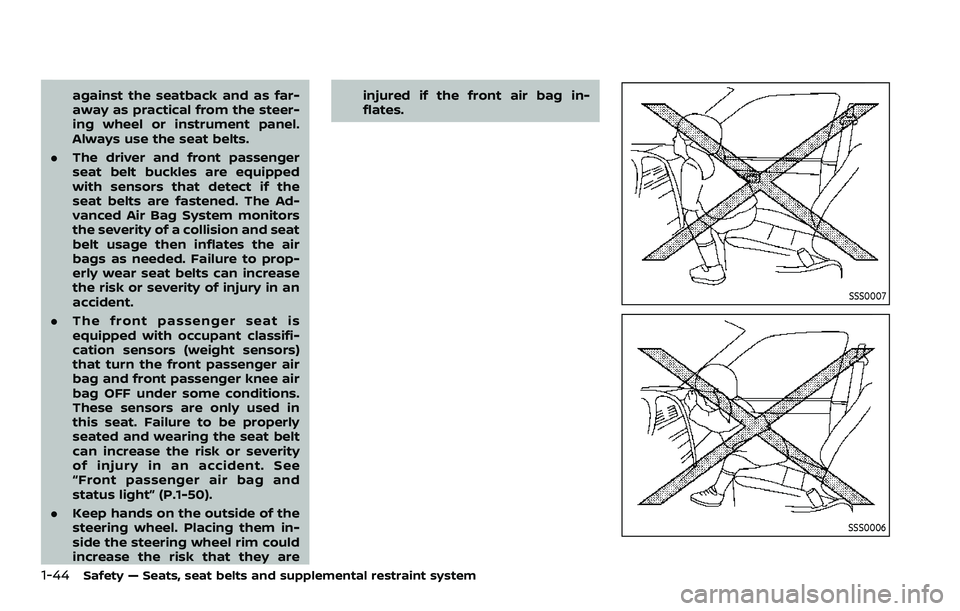
1-44Safety — Seats, seat belts and supplemental restraint system
against the seatback and as far-
away as practical from the steer-
ing wheel or instrument panel.
Always use the seat belts.
. The driver and front passenger
seat belt buckles are equipped
with sensors that detect if the
seat belts are fastened. The Ad-
vanced Air Bag System monitors
the severity of a collision and seat
belt usage then inflates the air
bags as needed. Failure to prop-
erly wear seat belts can increase
the risk or severity of injury in an
accident.
. The front passenger seat is
equipped with occupant classifi-
cation sensors (weight sensors)
that turn the front passenger air
bag and front passenger knee air
bag OFF under some conditions.
These sensors are only used in
this seat. Failure to be properly
seated and wearing the seat belt
can increase the risk or severity
of injury in an accident. See
“Front passenger air bag and
status light” (P.1-50).
. Keep hands on the outside of the
steering wheel. Placing them in-
side the steering wheel rim could
increase the risk that they are injured if the front air bag in-
flates.
SSS0007
SSS0006
Page 63 of 516
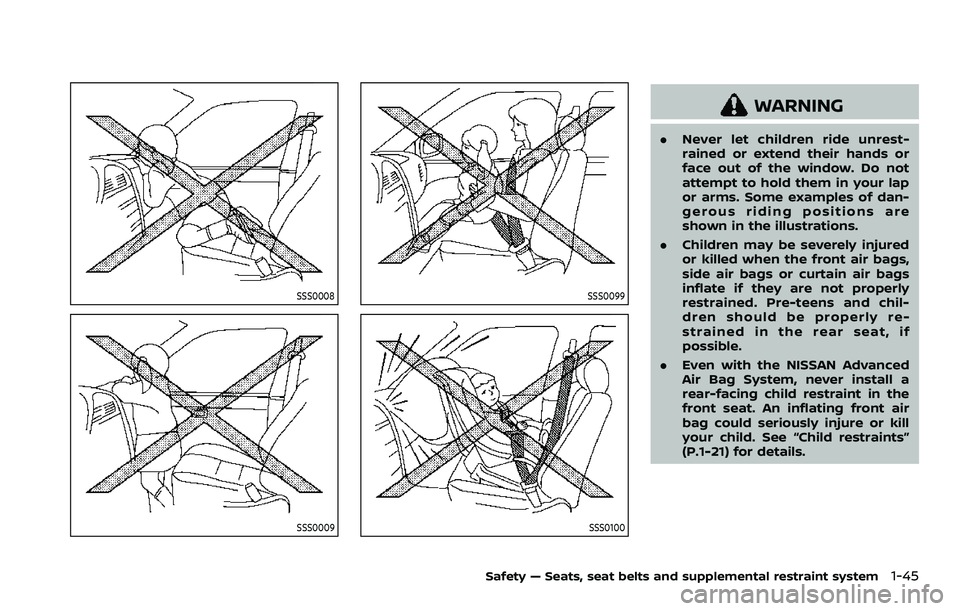
SSS0008
SSS0009
SSS0099
SSS0100
WARNING
.Never let children ride unrest-
rained or extend their hands or
face out of the window. Do not
attempt to hold them in your lap
or arms. Some examples of dan-
gerous riding positions are
shown in the illustrations.
. Children may be severely injured
or killed when the front air bags,
side air bags or curtain air bags
inflate if they are not properly
restrained. Pre-teens and chil-
dren should be properly re-
strained in the rear seat, if
possible.
. Even with the NISSAN Advanced
Air Bag System, never install a
rear-facing child restraint in the
front seat. An inflating front air
bag could seriously injure or kill
your child. See “Child restraints”
(P.1-21) for details.
Safety — Seats, seat belts and supplemental restraint system1-45
Page 64 of 516
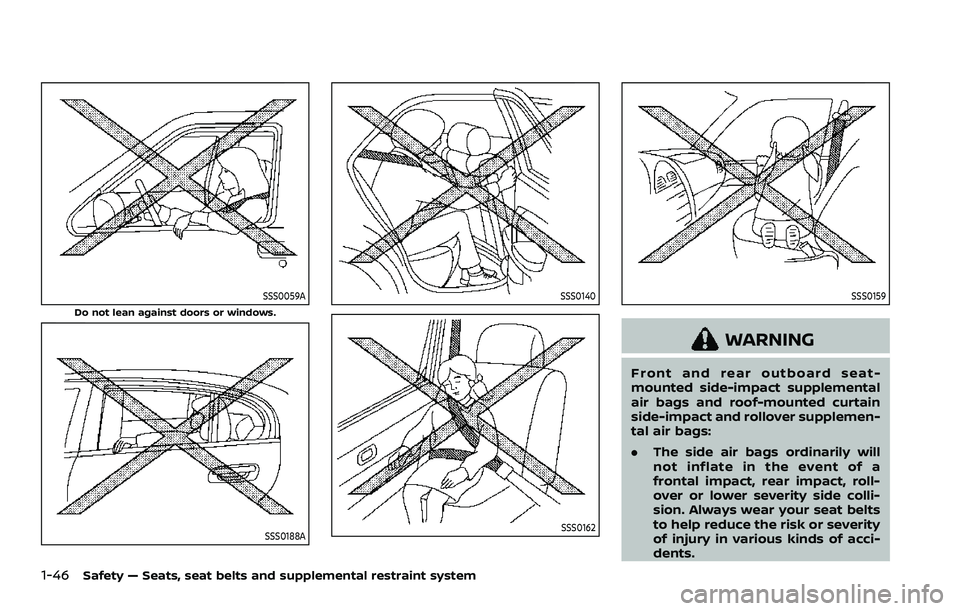
1-46Safety — Seats, seat belts and supplemental restraint system
SSS0059A
Do not lean against doors or windows.
SSS0188A
SSS0140
SSS0162
SSS0159
WARNING
Front and rear outboard seat-
mounted side-impact supplemental
air bags and roof-mounted curtain
side-impact and rollover supplemen-
tal air bags:
.The side air bags ordinarily will
not inflate in the event of a
frontal impact, rear impact, roll-
over or lower severity side colli-
sion. Always wear your seat belts
to help reduce the risk or severity
of injury in various kinds of acci-
dents.
Page 65 of 516
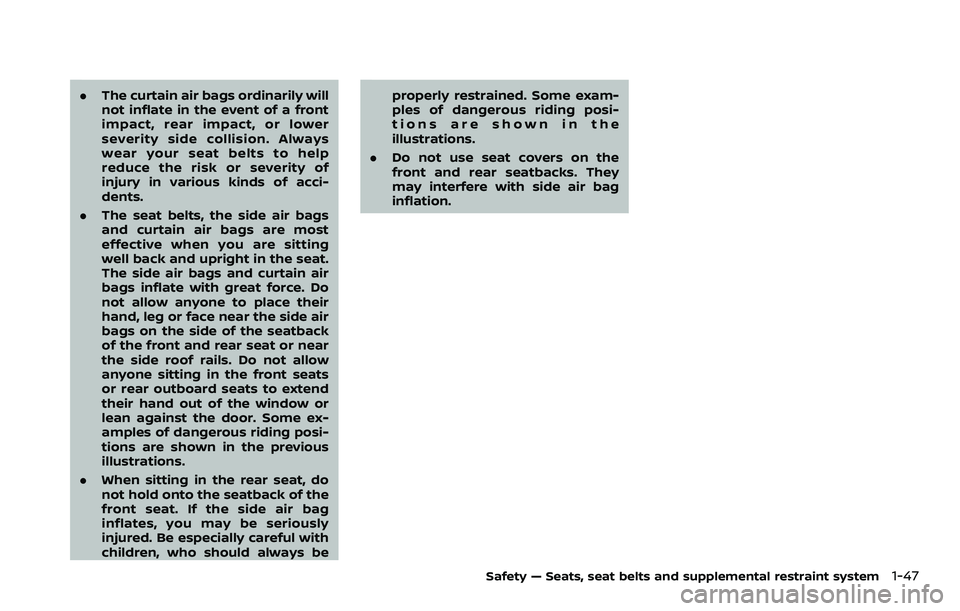
.The curtain air bags ordinarily will
not inflate in the event of a front
impact, rear impact, or lower
severity side collision. Always
wear your seat belts to help
reduce the risk or severity of
injury in various kinds of acci-
dents.
. The seat belts, the side air bags
and curtain air bags are most
effective when you are sitting
well back and upright in the seat.
The side air bags and curtain air
bags inflate with great force. Do
not allow anyone to place their
hand, leg or face near the side air
bags on the side of the seatback
of the front and rear seat or near
the side roof rails. Do not allow
anyone sitting in the front seats
or rear outboard seats to extend
their hand out of the window or
lean against the door. Some ex-
amples of dangerous riding posi-
tions are shown in the previous
illustrations.
. When sitting in the rear seat, do
not hold onto the seatback of the
front seat. If the side air bag
inflates, you may be seriously
injured. Be especially careful with
children, who should always be properly restrained. Some exam-
ples of dangerous riding posi-
tions are shown in the
illustrations.
. Do not use seat covers on the
front and rear seatbacks. They
may interfere with side air bag
inflation.
Safety — Seats, seat belts and supplemental restraint system1-47
Page 66 of 516

1-48Safety — Seats, seat belts and supplemental restraint system
WAB0046X
1. Supplemental front-impact air bag mod-ules (NISSAN Advanced Air Bags)
2. Air bag Control Unit (ACU)
3. Occupant classification sensors (weight sensors)
4. Occupant classification system control unit
5. Front seat-mounted side-impact supple- mental air bag modules
6. Roof-mounted curtain side-impact and rollover supplemental air bag inflators
7. Roof-mounted curtain side-impact and rollover supplemental air bag modules
8. Crash zone sensor
9. Driver and front passenger supplemental knee air bags 10. Front door pressure sensors (driver’s side
shown; front passenger side similar)
11. Lap outer pretensioners
12. Seat belt with pretensioners (front seats)
13. Satellite sensors
14. Rear outboard seat-mounted side-impact supplemental air bag modules
15. Seat belt with pretensioners (rear out- board seats)
NISSAN ADVANCED AIR BAG SYS-
TEM (front seats)
WARNING
To ensure proper operation of the
passenger’s Advanced Air Bag sys-
tem, please observe the following
items.
.Do not allow a passenger in the
rear seat to push or pull on the
seatback pocket.
. Do not place heavy loads heavier
than 9.1 lbs (4 kg) on the seat-
back, head restraint or in the
seatback pocket.
. Make sure nothing is pressing
against the rear of the seatback,
such as a child restraint installed
in the rear seat or an object
stored on the floor.
Page 67 of 516
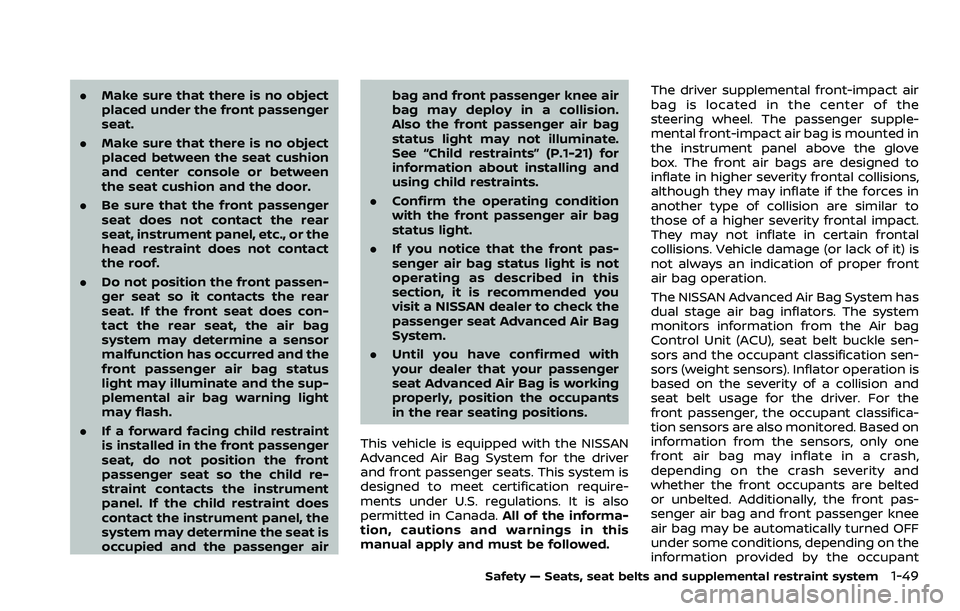
.Make sure that there is no object
placed under the front passenger
seat.
. Make sure that there is no object
placed between the seat cushion
and center console or between
the seat cushion and the door.
. Be sure that the front passenger
seat does not contact the rear
seat, instrument panel, etc., or the
head restraint does not contact
the roof.
. Do not position the front passen-
ger seat so it contacts the rear
seat. If the front seat does con-
tact the rear seat, the air bag
system may determine a sensor
malfunction has occurred and the
front passenger air bag status
light may illuminate and the sup-
plemental air bag warning light
may flash.
. If a forward facing child restraint
is installed in the front passenger
seat, do not position the front
passenger seat so the child re-
straint contacts the instrument
panel. If the child restraint does
contact the instrument panel, the
system may determine the seat is
occupied and the passenger air bag and front passenger knee air
bag may deploy in a collision.
Also the front passenger air bag
status light may not illuminate.
See “Child restraints” (P.1-21) for
information about installing and
using child restraints.
. Confirm the operating condition
with the front passenger air bag
status light.
. If you notice that the front pas-
senger air bag status light is not
operating as described in this
section, it is recommended you
visit a NISSAN dealer to check the
passenger seat Advanced Air Bag
System.
. Until you have confirmed with
your dealer that your passenger
seat Advanced Air Bag is working
properly, position the occupants
in the rear seating positions.
This vehicle is equipped with the NISSAN
Advanced Air Bag System for the driver
and front passenger seats. This system is
designed to meet certification require-
ments under U.S. regulations. It is also
permitted in Canada. All of the informa-
tion, cautions and warnings in this
manual apply and must be followed. The driver supplemental front-impact air
bag is located in the center of the
steering wheel. The passenger supple-
mental front-impact air bag is mounted in
the instrument panel above the glove
box. The front air bags are designed to
inflate in higher severity frontal collisions,
although they may inflate if the forces in
another type of collision are similar to
those of a higher severity frontal impact.
They may not inflate in certain frontal
collisions. Vehicle damage (or lack of it) is
not always an indication of proper front
air bag operation.
The NISSAN Advanced Air Bag System has
dual stage air bag inflators. The system
monitors information from the Air bag
Control Unit (ACU), seat belt buckle sen-
sors and the occupant classification sen-
sors (weight sensors). Inflator operation is
based on the severity of a collision and
seat belt usage for the driver. For the
front passenger, the occupant classifica-
tion sensors are also monitored. Based on
information from the sensors, only one
front air bag may inflate in a crash,
depending on the crash severity and
whether the front occupants are belted
or unbelted. Additionally, the front pas-
senger air bag and front passenger knee
air bag may be automatically turned OFF
under some conditions, depending on the
information provided by the occupant
Safety — Seats, seat belts and supplemental restraint system1-49
Page 68 of 516
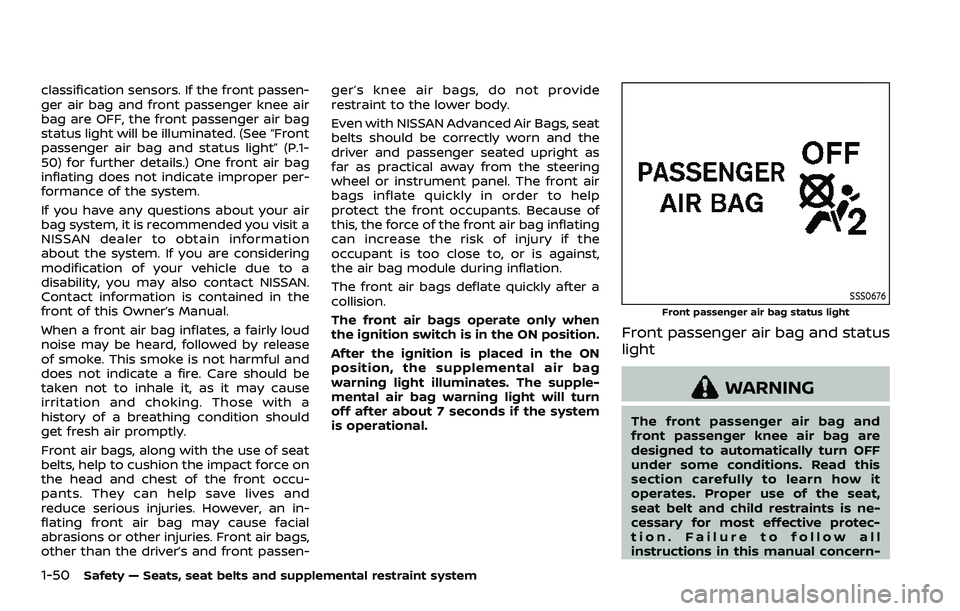
1-50Safety — Seats, seat belts and supplemental restraint system
classification sensors. If the front passen-
ger air bag and front passenger knee air
bag are OFF, the front passenger air bag
status light will be illuminated. (See “Front
passenger air bag and status light” (P.1-
50) for further details.) One front air bag
inflating does not indicate improper per-
formance of the system.
If you have any questions about your air
bag system, it is recommended you visit a
NISSAN dealer to obtain information
about the system. If you are considering
modification of your vehicle due to a
disability, you may also contact NISSAN.
Contact information is contained in the
front of this Owner’s Manual.
When a front air bag inflates, a fairly loud
noise may be heard, followed by release
of smoke. This smoke is not harmful and
does not indicate a fire. Care should be
taken not to inhale it, as it may cause
irritation and choking. Those with a
history of a breathing condition should
get fresh air promptly.
Front air bags, along with the use of seat
belts, help to cushion the impact force on
the head and chest of the front occu-
pants. They can help save lives and
reduce serious injuries. However, an in-
flating front air bag may cause facial
abrasions or other injuries. Front air bags,
other than the driver’s and front passen-ger’s knee air bags, do not provide
restraint to the lower body.
Even with NISSAN Advanced Air Bags, seat
belts should be correctly worn and the
driver and passenger seated upright as
far as practical away from the steering
wheel or instrument panel. The front air
bags inflate quickly in order to help
protect the front occupants. Because of
this, the force of the front air bag inflating
can increase the risk of injury if the
occupant is too close to, or is against,
the air bag module during inflation.
The front air bags deflate quickly after a
collision.
The front air bags operate only when
the ignition switch is in the ON position.
After the ignition is placed in the ON
position, the supplemental air bag
warning light illuminates. The supple-
mental air bag warning light will turn
off after about 7 seconds if the system
is operational.
SSS0676
Front passenger air bag status light
Front passenger air bag and status
light
WARNING
The front passenger air bag and
front passenger knee air bag are
designed to automatically turn OFF
under some conditions. Read this
section carefully to learn how it
operates. Proper use of the seat,
seat belt and child restraints is ne-
cessary for most effective protec-
tion. Failure to follow all
instructions in this manual concern-
Page 69 of 516
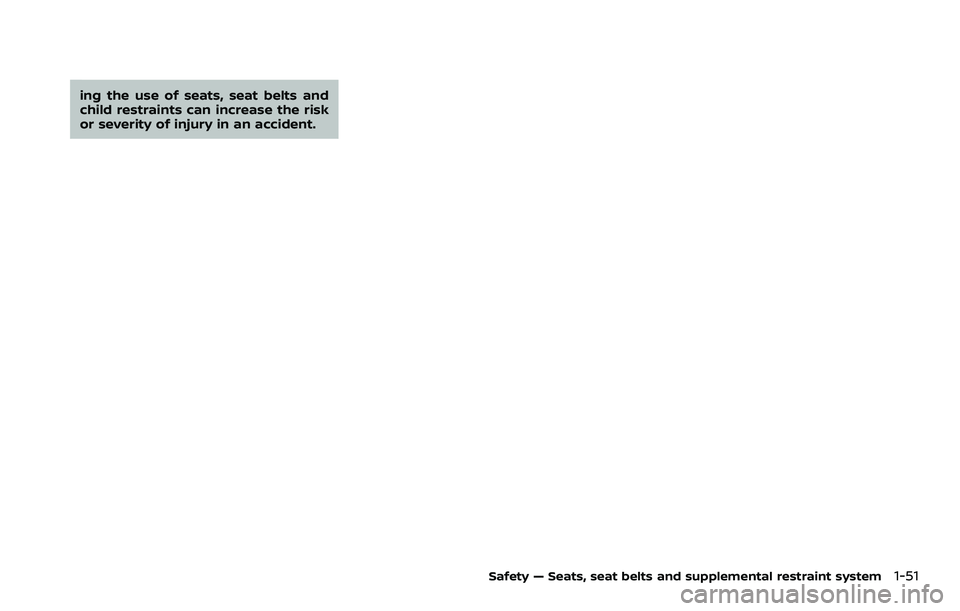
ing the use of seats, seat belts and
child restraints can increase the risk
or severity of injury in an accident.
Safety — Seats, seat belts and supplemental restraint system1-51
Page 70 of 516
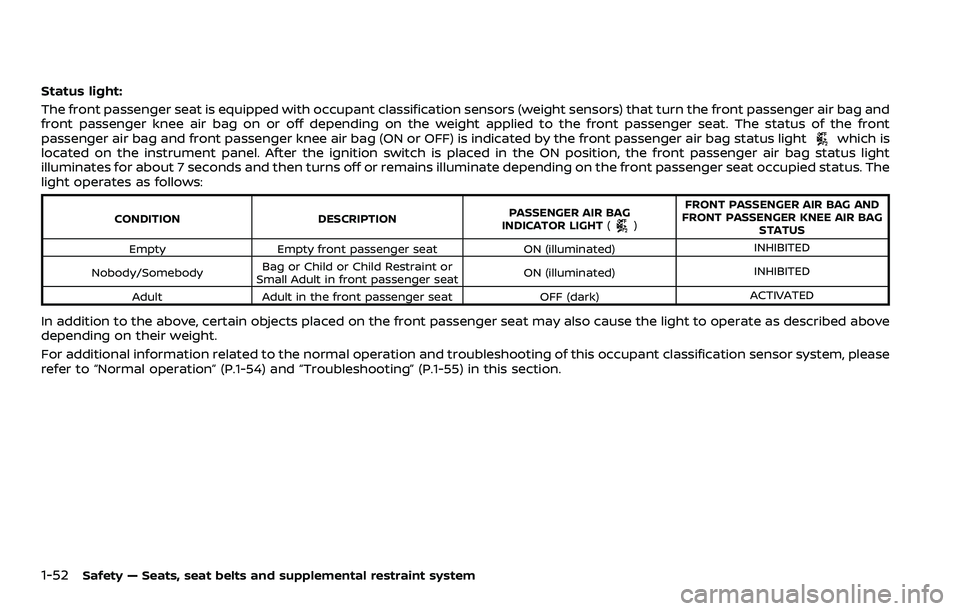
1-52Safety — Seats, seat belts and supplemental restraint system
Status light:
The front passenger seat is equipped with occupant classification sensors (weight sensors) that turn the front passenger air bag and
front passenger knee air bag on or off depending on the weight applied to the front passenger seat. The status of the front
passenger air bag and front passenger knee air bag (ON or OFF) is indicated by the front passenger air bag status light
which is
located on the instrument panel. After the ignition switch is placed in the ON position, the front passenger air bag status light
illuminates for about 7 seconds and then turns off or remains illuminate depending on the front passenger seat occupied status. The
light operates as follows:
CONDITION DESCRIPTIONPASSENGER AIR BAG
INDICATOR LIGHT ()FRONT PASSENGER AIR BAG AND
FRONT PASSENGER KNEE AIR BAG STATUS
Empty Empty front passenger seat ON (illuminated)INHIBITED
Nobody/Somebody Bag or Child or Child Restraint or
Small Adult in front passenger seat ON (illuminated)
INHIBITED
Adult Adult in the front passenger seat OFF (dark)ACTIVATED
In addition to the above, certain objects placed on the front passenger seat may also cause the light to operate as described above
depending on their weight.
For additional information related to the normal operation and troubleshooting of this occupant classification sensor system, please
refer to “Normal operation” (P.1-54) and “Troubleshooting” (P.1-55) in this section.